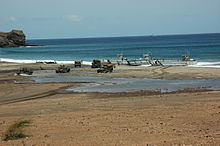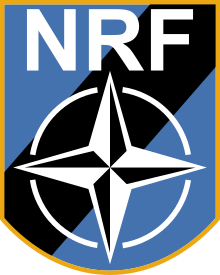NATO Response Force
The NATO Response Force ( NRF , German NATO Response Force ) is a reaction force of NATO , which in a time of high availability due to its modular design in a broad spectrum of possible operations can be used. It consists of contingents of ground forces, air forces, naval units and special forces.
history
At the informal meeting of NATO defense ministers in Warsaw from 23-25. In September 2002, then US Secretary of Defense Donald Rumsfeld proposed the establishment of a rapid reaction force. At the NATO summit in Prague on 21./22. In November 2002, the heads of state and government decided to set up the NRF and commissioned the development of a comprehensive concept. Five months later, the NATO Military Committee laid down the most important military framework conditions for the establishment and operation of the NRF in policy documents. The overall concept followed at the spring meeting of NATO defense ministers on 12/13. June 2003. Among other things, criteria for installation, training and certification and the further implementation steps were defined.
The concept development and implementation phases partially overlapped. On October 15, 2003, the “Implementation Stage NRF” officially began, still with limited skills and a 30-day readiness for installation as the first test of the NRF procedures and structures. On October 13, 2004, after the DESTINED GLORY '04 exercise in Sardinia, the provisional (conditional) NRF (Initial Operational Capability) was declared with around 17,000 soldiers. In 2005, parts of the NRF were used for disaster relief, in particular for the transport of relief supplies, in the USA ( Hurricane Katrina ) and in Pakistan ( earthquake relief ).

On the Cape Verde NATO tested from June 1 to July 12, 2006 the operational capability of the NRF for the first time with a big maneuver . 6,500 soldiers took part in the Steadfast Jaguar exercise , including 2,000 German soldiers. The German contingent included soldiers from the Franco-German Brigade and the 292 Jäger Battalion as well as the frigate Augsburg , the task force supply company Berlin and other units of the Navy .
This major NATO maneuver was coordinated in accordance with the rotation principle for the naval forces ( MARFOR ) by the Spanish base in Rota , for the air forces by Ramstein Air Base and the command ship and mobile command post operated by the amphibious command ship USS Mount Whitney (LCC-20) , which is also the flagship the 6th US fleet . The German General Gerhard Back was in command of the NRF exercise .
At the NATO summit in Riga in November 2006, the declaration of full operational capability was finally made, after this had been demonstrated with NRF forces in June 2006 during exercise STEADFAST JAGUAR on the Cape Verde Islands.
In July 2007 the operational readiness of the NRF was questioned by the NATO Commander in Chief ( SACEUR ) US General Craddock , since the NRF did not have or insufficiently required capabilities of the NRF due to a lack of readiness to provide forces in the NRF- CJSOR . At the meeting of NATO defense ministers in Noordwijk at the end of October 2007, it was therefore decided to adapt the NRF concept. The implementation is still pending.
In March 2008, the NATO non-member Finland decided to support the NRF, but without participating in the troop rotation.
Several military maneuvers took place in 2015 as part of the realignment of the NRF . Including laying exercises from the Noble Jump series from April 1 to 10, 2015 in the Netherlands and the Czech Republic. 1,500 soldiers from 11 countries were involved, including the Czech 43rd Airborne Battalion from Chrudim , the Dutch 11 Luchtmobiele Brigade and 750 Bundeswehr soldiers from the 371 Panzer Grenadier Battalion from Marienberg. From June 9th to 20th, the Noble Jump II maneuver took place in Żagań (Poland). From October 21 to November 6, 2015, the major maneuver Trident Juncture 2015 took place in Italy, Spain and Portugal with over 25,000 soldiers from over 30 nations, including 3,000 German armed forces . The maneuver was prepared by the Multinational Command Operational Command of the Bundeswehr.
idea
With the creation of the NRF, two goals were pursued:
- On the one hand, a highly efficient force plan should be put together with a very high availability (can be relocated within 5 to 30 days). With the ability to deploy worldwide, any crises that may arise should be contained or prevented at an early stage by means of deterrence - i.e. before an actual military deployment. The range of possible missions of the NRF encompasses the entire spectrum of NATO operations, such as humanitarian aid, evacuation operations, enforcement of embargoes, support after terrorist attacks, the fight against terrorist forces, right up to combat missions as "Initial Entry Force" (forces from the very beginning) .
- In the context of the transformation, the NRF serves to improve the operational capability of the NATO armed forces, especially the European components. The stated objective is to use the NRF to increasingly improve the capabilities of the respective national armed forces. Above all, the focus is on the ability to strategically relocate forces and improve interoperability in order to be able to carry out joint and multinational operations. This is to be achieved primarily through joint exercises and the development of common standards .
NRF in the force structure of NATO
The NRF is not an independent, newly established element. Rather, it draws on the existing forces of the NATO armed forces structure. These are reported to NATO alternately as part of a preparatory phase for exercises and reviews and (currently) kept in increased readiness for one year. Among other things, this approach is intended to ensure that as many associations as possible participate in the improvement process.
At the same time, however, this is the greatest challenge for many nations: In the case of deployments running in parallel, an NRF assignment means an additional, possibly excessive burden on the armed forces. In addition, participation in the exercise and the required material equipment mean high financial burdens for the troop provider, which often cannot be afforded against the background of overstretched defense budgets .
composition
The NRF has a strength of approximately 25,000 soldiers. It is made up of land forces up to brigade strength , naval forces up to the strength of a "NATO Task Force" (an aircraft carrier combat group ), air forces for up to 200 operations per day and necessary support forces. It is sustainable for up to 30 days.
The operational management of the NRF is carried out by headquarters of the NATO command structure ( JFC Brunssum / JFC Naples / JHQ Lisbon (dissolved since December 2012) ) for twelve months at a time.
Structure of the NRF since 2015
The NRF structure under the Readiness Action Plan consists of four elements:
- the relocatable multinational headquarters Joint Task Force HQ
- the very high readiness joint task force (VJTF)
- the followers in the initial phase; Initial Follow On Forces Group (IFFG), consisting of rapid deployable intervention forces who follow the VJTF in a crisis and
- the Follow-on Forces Group (FFG)
On June 24, 2015, the defense ministers of the NATO member states agree to increase the NRF from the current 13,000 to 40,000 soldiers.
Basics of use
The decision to use the NRF meet NATO countries must unanimously NAC (North Atlantic Council). Once this has been done, the necessary skills are determined as part of the operation planning. The member states that have made these capabilities available in the CJSOR indicate with an official confirmation whether they are releasing or releasing their reported forces for this mission. This release is subject to parliamentary approval in Germany .
See also
Web links
Official information
- NATO (English) ( Memento from March 20, 2004 in the Internet Archive )
- Allied Command Operations (English) ( Memento of 20 October 2003 at the Internet Archive )
- Assessment of the NATO Response Force in the NATO REVIEW (English)
- Allied Rapid Reaction Corps (English) ( Memento from October 30, 2003 in the Internet Archive )
- US Marine - Center for Contemporary Conflict (English)
- http://www.airramstein.nato.int/topics.htm ( Memento from March 5, 2009 in the Internet Archive )
NRF in the press
- Christiane Buck, War Game on Cape Verde , in: Die Welt, June 27, 2006
- Michèle Alliot-Marie on WELT.de from November 7, 2006
- European Security 10/2007
- Düsseldorf Institute for Foreign and Security Policy 11/2005
Individual evidence
- ↑ www.nato.int: Initial Operational Capability: Achieved!
- ^ History of the NRF ( Memento of the original from April 23, 2008 in the Internet Archive ) Info: The archive link was inserted automatically and has not yet been checked. Please check the original and archive link according to the instructions and then remove this notice.
- ↑ Janes ( Memento of October 16, 2006 in the Internet Archive )
- ↑ www.bundeswehr.de
- ^ Handelsblatt report ( Memento of April 23, 2008 in the Internet Archive )
- ↑ Tagesschau: NATO reaction force apparently only in mini format (tagesschau.de archive)
- ^ Embassy of Finland
- ↑ FAZ.net: In the sign of the trident
- ↑ Transformation ( Memento from June 4, 2006 in the Internet Archive )
- ↑ Defense Minister decide to bolster the NATO Response Force, reinforce collective defense. NATO , June 24, 2015, accessed June 24, 2015 .
- ↑ Decision-making processes in NATO ( Memento from June 4, 2006 in the Internet Archive )
- ↑ Parliament reservation ( Memento of the original from April 23, 2008 in the Internet Archive ) Info: The archive link was inserted automatically and has not yet been checked. Please check the original and archive link according to the instructions and then remove this notice.
